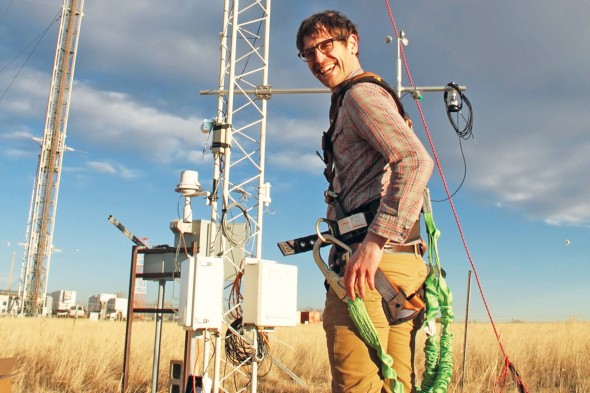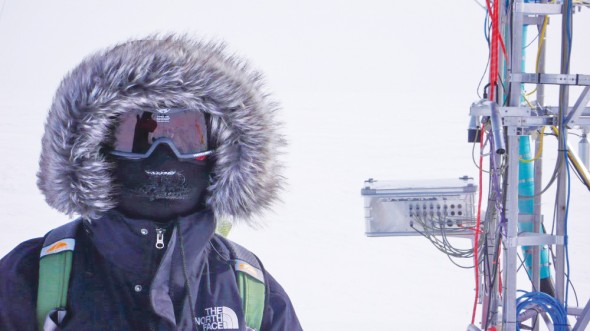Keeping an eye on weather around world

Max Berkelhammer studies climate change across the globe. “The bigger question I’m interested in is processes where the atmosphere and land surface meet,” says Berkelhammer, assistant professor of earth and environmental sciences.
Scientists need data if they’re going to make the planet a healthier place. Max Berkelhammer is helping to supply the numbers.
His quest has taken him around the world: to India, Greenland, Bermuda and the Rocky Mountains of Colorado.
“The bigger question I’m interested in is processes where the atmosphere and land surface meet, and how those processes affect global precipitation and water cycles,” said Berkelhammer, assistant professor of earth and environmental sciences in the College of Liberal Arts and Sciences.
Recently he visited Bermuda to measure carbonyl sulfide in the ocean.
“Plants use carbonyl sulfide when they photosynthesize,” he said. “We measure it and see how the plants take it in and how the oceans are producing it.
“Knowing the rate at which this molecule forms helps us understand how ecosystems respond to changing climate.”
One of his instruments was high on a tower — until Hurricane Gonzalo blew it over.
“We were in a bit of a pickle,” Berkelhammer said.
He has spent parts of the last four summers in Greenland on a National Science Foundation project.
Greenland’s coasts are melting. But he’s at Summit Station, at 10,000 feet the highest point on the ice sheet. There, where it’s freezing year-round, the ice is accumulating.
With equipment set up on the ice surface and at the top of a 150-foot tower, Berkelhammer takes measurements.
“I try to think about all the things that are adding to the ice sheet — precipitation, blowing snow and condensation — and all the things that are taking away — sublimation, where ice passes into vapor without first becoming liquid, and evaporation,” he said.
He’s been to India a number of times, starting when he was a graduate student. “I’m interested in what causes droughts in the monsoon,” he said. “There are periods of 15 to 20 years when the monsoon is weak.”
India is one of the rainiest places on Earth, ordinarily accumulating as much as feet of water a year.
Berkelhammer can see when big droughts occurred by studying cave stalagmites that are formed from minerals deposited layer by layer. He drills off powder, then uses a mass spectrometer to see how many heavy isotopes, which relate to wet and dry periods, are present.
“Whether large droughts are more likely in response to global warming is a complex enigma,” he said.
He also looks at isotopes in tree rings at a site in the Rocky Mountains outside of Boulder, Colorado.
At the Mountain Research Station, on the 9,500-foot Niwot Ridge, he studies ecosystem water use — “how much of the water from the surface into the atmosphere is from trees and how much evaporates from soil.”
The U.S. Geological Survey maintains 57 sites from New Mexico to Montana, all in the Rockies. Every year on April 1, the agency sends him a bottle of melted snow from each site. He analyzes of how evaporation, condensation and sublimation affect the snowpack.
Snow is melting earlier in the spring because of global warming. “If things continue to warm,” Berkelhammer said, “how early will it start melting in the future?”
Slower melting percolates water into the soil over a longer period. “Otherwise, it melts fast and much of it runs off without getting absorbed into the soil, and therefore is not available to trees later in the season,” he said.
As a result, he added, trees may be more susceptible to fire.
Berkelhammer comes from Providence, Rhode Island. He earned his bachelor’s degree at Pomona College in Claremont, California, and his Ph.D. at the University of Southern California, with post-doc work at the University of Colorado Boulder. He joined UIC last January.
A resident of the Andersonville neighborhood, he plays the banjo. He hiked the Appalachian Trail in 2001.
“I love to be outside,” Berkelhammer said. “That’s part of the reason I ended up pursuing earth sciences — I try to get out in the field for a month or two every year.”

